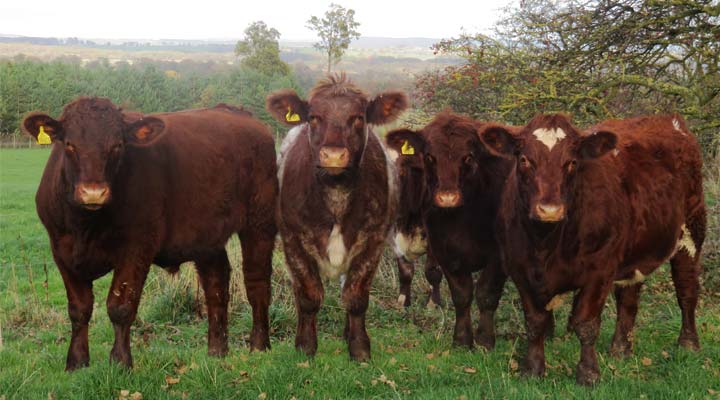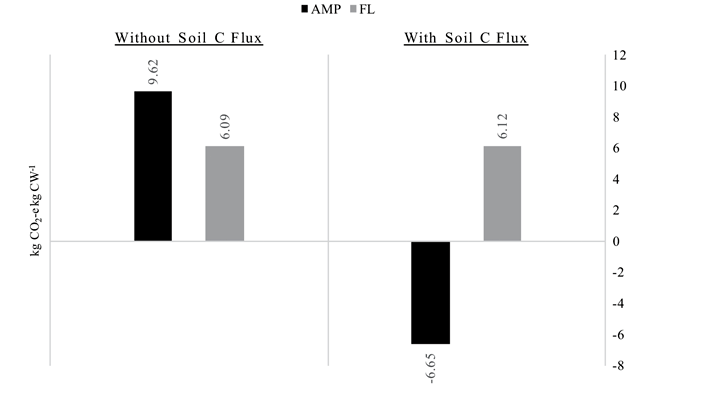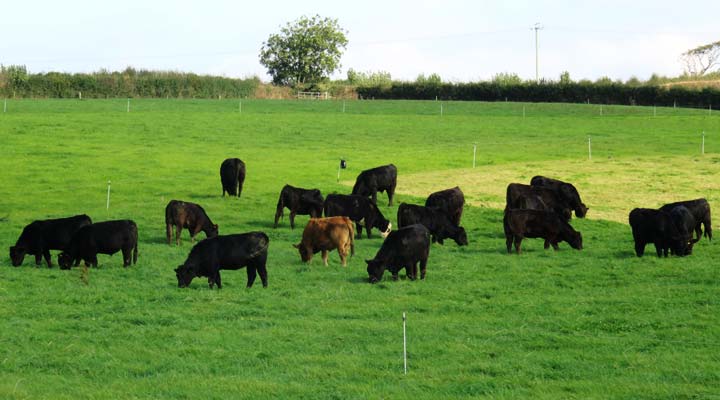New beef systems research includes soil carbon measurements for first time

Results of new research from Michigan State University comparing beef production from grassland managed under ‘short duration, high intensity grazing’ (mob grazing or holistic planned grazing), to beef on intensive feedlots, has found lower greenhouse gas (GHG) emissions and improved soil organic carbon content (SOC) from grass finishing.
This is the first piece of scientific research that has compared these two systems – previous research has only looked at continuous grazing or set stocking and assumed a constant level of soil organic carbon.
When researchers measured the amount of SOC captured into the GHG footprint calculations, the emissions from the grazing system were -6.65kg CO2-e per kg of carcass weight, ie creating a GHG sink, compared with feedlot emissions or losses of +6.12kg CO2-e kg of carcass weight.
Researchers also showed a four-year carbon sequestration average of 3.59 tonnes C ha/year in the grazed pastures, while the feedlot system showed a potentially small net loss of soil carbon through soil erosion from the crops grown to feed the animals.
“There are two reasons why this piece of research is so important,”
says Dave Stanley, the director responsible for research at the Pasture-Fed Livestock Association.
“In previous trials, continuous grazing of beef cattle was compared to feed lot production, yet we know this is not the best way to manage grassland, as this has low productivity and negatively impacts plant communities.
“This is the first time that mob grazing, which allows a significant recovery period after grazing, has been used. The difference is startling, but in line with other research on grassland sequestration rates.
“Secondly, most studies on ruminant emissions have never considered the wider aspects of the carbon cycle and the potential for soil carbon sequestration in well managed grasslands. This study shows soil carbon to be an important part of the ruminant greenhouse gas emissions story.
“Increased soil carbon also increases water capture, dramatically enhances soil fertility and nutrient availability and increases forage quality and quantity.”
On trial
The research looked at five years data using 210 Red Angus steers each year, that were weaned onto grass at seven months of age. They were mob grazed from mid May until November, at which point they were fed lucerne hay and stockpiled forage until slaughter in early to mid December.
On average steers finished at 530kg liveweight in the 200-day finishing phase. They were grazed on high quality, predominantly lucerne, cool season mix pastures at a stocking rate of 2.76 steers/ha and rotated among paddocks according to forage availability and quality.
Rotation frequency focused on preventing overgrazing and assuring forage recovery, allowing appropriate regrowth before being grazed again.
The feedlot finishing system was based on Red Angus steers originating from the same group as the mob grazed steers. They were fed a ration containing maize grain, high moisture maize, maize silage, lucerne hay and dried distillers grains with solubles. Imported soya was not part of the feed.
Table 1: Animal production characteristics from feedlot and mob grazing finishing strategies
| Characteristic | Feedlot | Mob Grazing |
|---|---|---|
| Days in finishing phase | 171.5 | 200.8 |
| Start-End liveweight (kg) | 361-654 | 362-528 |
| Mean carcass weight (kg) | 406 | 280 |
| Average Daily Gain (kg) | 1.8 | 0.9 |
| Dry Matter Intake (kg/d) | 9.9 | 11.0 |
| Feed Conversion Ratio (DMI÷ADG) | 5.7 | 13.0 |
The mob grazed steers finished 150 days shorter and 99kg heavier than any continuously grazed steers in previous studies – reflecting the quality and amount of pasture they were eating, which had much higher digestible energy content.
Table 2: Greenhouse gas (GHG) emissions (kg CO2-e)/steer in the feedlot and mob grazed finishing strategies with no accounting for changes in soil carbon.
| Impact category by production system | GHG emissions (kg CO2-e/steer) | % of total |
|---|---|---|
| Feedlot | 2470.4 | |
| Enteric methane (CH4) | 777.0 | 31% |
| Manure emissions | 732.7 | 30% |
| Feed emissions | 905.4 | 37% |
| Mineral supplement emissions | 1.3 | 0.05% |
| On-farm energy and transportation | 54.1 | 2% |
| Carcass weight (kg) | 405.8 | |
| Total (kg CO2 per kg carcass weight) | 6.09 | |
| Mob grazing | 2694.6 | |
| Enteric methane (CH4) | 1434.1 | 53% |
| Manure emissions | 688.3 | 26% |
| Feed emissions | 512.0 | 19% |
| Mineral emissions | 0.8 | 0.03% |
| On-farm energy and transportation | 59.5 | 2% |
| Carcass weight (kg) | 280.2 | |
| Total (kg CO2 per kg carcass weight) | 9.62 |
In this study, GHG emissions from mob grazed steers were 45% lower than a study carried out looking at continuous grass-finishing in 2010 by American researcher Nathan Pelletier.
With a longer timespan, there is no doubt that outdoor grazed cattle do produce a greater output of enteric methane, which is a byproduct of bacterial activity in the rumen which is released by burping.
There is however, concern that the standard Intergovernmental Panel on Climate Change (IPCC) accounting methodology used, overestimates the amount of methane released from grazing animals, especially when they are grazing, more digestible, higher quality forages.
Carbon capture in the soil
When the two systems were compared without taking into account the loss or accumulation of carbon in the soil, the feedlot beef, as with many previous reports, had a lower carbon footprint.
However, when changes in soil carbon content were included the results reversed significantly to be +6.12kg CO2 per kg of carcass weight emissions for the feed lot steers and -6.65kg CO2 per kg of carcass weight sink or draw-down in the grazed animals.

The results of the amount of carbon captured under mob grazing of 3.59 tonnes C/ha/year is considerably greater than shown in earlier studies and is expected to continue to accumulate in the trial fields in future, though possibly at a reducing rate.
The greater C sequestration and resulting net GHG sink in the mob grazing, calls into question the common assumption that feedlot intensification reduces the overall GHG footprint through greater productivity. This study, whilst only carried out in one region, shows that when the carbon cycle is given fuller consideration and soil ecology improvements are included, environmental benefits of mob grazing outweigh productivity losses.
The study acknowledges that mob grazing uses twice as much land and is not as productive as feedlots based in carcass yields. However, regenerative mob grazing systems offer opportunities to produce considerably greater amounts of beef on a land basis than continuous grazing, which is currently practiced by many American farmers.

It says that improved management can increase the output of grass-fed beef. Ultimately, in a closed system this implies somewhat lower per capita beef consumption, but greater environmental benefits, such as improved biodiversity and wildlife habitat, and better soil function, from what is consumed.
“This study is a significant step forward in laying to rest the myth that intensive, grain-fed rearing of livestock is less damaging to the planet than 100% grass-fed systems,” says Mr. Stanley. “Pasture-fed ruminants have an important role to play both in mitigating climate change and re-instating our degraded arable soils.
“Actually the benefits of pasture-fed systems are probably higher than this study suggests as the feedlot system did not use nitrogen fertilisers or feed imported soya, and so has lower GHGs than a typical intensive rearing system,” Mr. Stanley explains.
“We are involved in work in the UK looking at all the benefits of 100% grass-fed beef and lamb, including a significant BBSRC-funded three year programme which is examining the economic and social returns from 60 PFLA members, as well as the environmental benefits.
“We also hold practical, on-farm study meetings to try and assess and monitor the improvements in soil health and structure gained from growing pasture and grazing it. There is still much we need to know and the PFLA is helping farmers to do something about this.”
Additional Information
Download the full Report (PDF): Impacts of soil carbon sequestration on life cycle greenhouse gas emissions in Midwestern USA beef finishing systems



